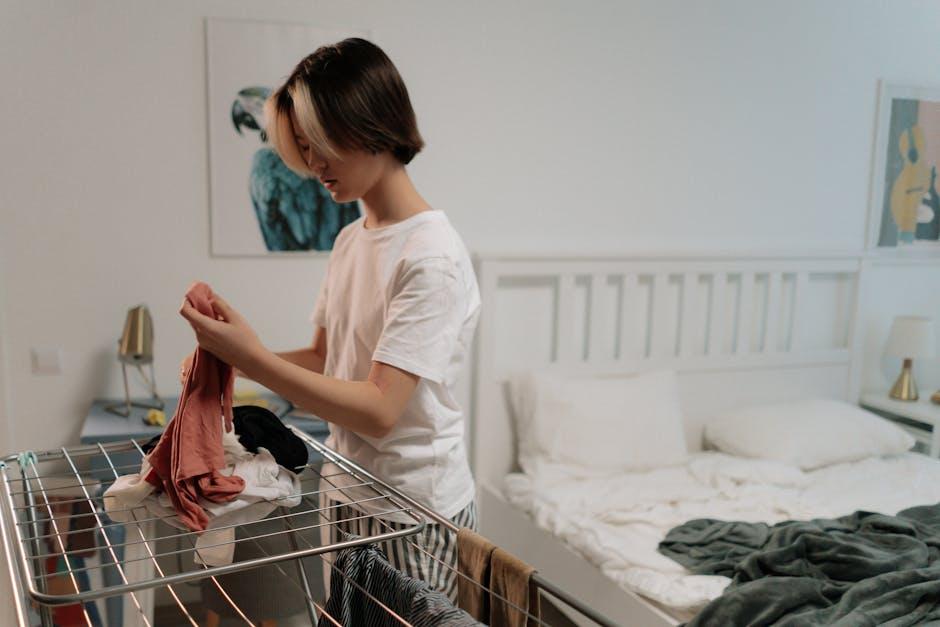In a world overflowing with possessions, the quest for clarity often begins not in the mind, but in our surroundings. The timeless link between a tidy environment and a peaceful mindset reveals itself in the simple act of decluttering. “” invites you to explore practical strategies that go beyond tidying up—it’s about creating room for focus, calm, and intentional living. Whether overwhelmed by clutter or simply seeking a fresh start, this guide offers thoughtful ways to transform chaos into order, reminding us that sometimes, less truly is more.
Table of Contents
- Understanding the Psychology Behind Clutter and Its Impact on Mental Clarity
- Room-by-Room Strategies for Targeted Decluttering Success
- Choosing the Right Tools and Storage Solutions to Maintain Order
- Incorporating Daily Habits to Sustain a Clear Space and Mind
- Insights and Conclusions

Understanding the Psychology Behind Clutter and Its Impact on Mental Clarity
Our minds are deeply influenced by the physical environments we inhabit, and clutter often acts like a fog that clouds our mental processes. Psychologically, clutter can trigger feelings of stress and anxiety because it constantly demands attention, even if we’re not consciously aware of it. This visual noise overloads our brain’s information processing capacity, making it harder to focus and prioritize tasks. Essentially, clutter competes for our mental resources, diminishing our ability to think clearly and creatively. Understanding this connection helps explain why a tidy space can feel so refreshing and empowering—it’s not just about aesthetics, but about freeing our minds from unnecessary distractions.
Moreover, clutter often embodies emotional baggage, from unfinished projects to sentimental items that hold complex memories. This creates an internal conflict where the desire for order clashes with feelings of guilt or attachment, making decluttering a challenging emotional journey. Recognizing this dynamic is key to approaching decluttering compassionately and effectively. Below is a quick overview of how clutter impacts different psychological aspects:
| Psychological Aspect | Impact of Clutter |
|---|---|
| Focus & Concentration | Reduced ability to stay on task due to visual distractions |
| Stress Levels | Increased cortisol production; heightened anxiety |
| Emotional Well-being | Feelings of overwhelm and guilt |
| Productivity | Difficulty prioritizing and completing tasks |
- Clutter acts as a constant reminder of tasks undone, amplifying stress.
- It disrupts visual harmony, making it difficult for the brain to settle into focus.
- Letting go of clutter often requires addressing underlying emotional attachments.

Room-by-Room Strategies for Targeted Decluttering Success
Kitchen: Tackle countertops first to clear visible clutter, creating a fresh workspace. Use clear storage containers for pantry items to enhance visibility and reduce waste. Be ruthless with duplicate gadgets—if you haven’t used it in a month, it’s time to let it go. Store frequently used utensils within easy reach while designating a drawer for seldom-used appliances.
Bedroom: Start by decluttering your nightstands and dresser tops, allowing your personal sanctuary to breathe. Implement the “seasonal swap” for clothes—store off-season attire out of the way to maximize closet space. Adopt a donation box for items no longer loved or worn, and make it a habit to revisit it monthly to prevent accumulation.
| Room | Focus Area | Quick Win |
|---|---|---|
| Kitchen | Countertops & Pantry | Clear expired food & duplicates |
| Bedroom | Closet & Nightstand | Seasonal wardrobe rotation |

Choosing the Right Tools and Storage Solutions to Maintain Order
Finding the perfect tools and storage solutions is a game-changer in the journey toward a clutter-free environment. By selecting items tailored to your space and lifestyle, you can transform chaos into calm with ease. Consider versatile options like stackable bins, modular shelving, and labeled containers that not only save space but also add an element of style to your rooms. Investing in multi-purpose storage encourages better organization habits and reduces the need to purchase new items repeatedly.
When choosing storage options, think about functionality and accessibility. For instance, frequently used items benefit from open shelves or clear bins for quick retrieval, while seasonal belongings fit well in vacuum-sealed bags or under-bed drawers. Below is a simple guide to match tools and solutions with common spaces:
| Space | Recommended Storage Tools | Benefits |
|---|---|---|
| Living Room | Multi-compartment coffee tables, baskets | Easy access and aesthetic appeal |
| Kitchen | Stackable containers, drawer dividers | Maximizes space, keeps items fresh |
| Bedroom | Under-bed storage boxes, hanging organizers | Utilizes hidden spaces, declutters surfaces |
- Label clearly to avoid wasting time searching
- Choose transparent containers for better visibility
- Use vertical space to keep floors free

Incorporating Daily Habits to Sustain a Clear Space and Mind
Adopting small, consistent actions each day can transform your living environment and mental clarity alike. Start by integrating quick tidying sessions into your routine, such as a 5-minute desk wipe-down or a daily sweep of clutter hotspots. Prioritize zones that tend to accumulate mess—like entryways, kitchen counters, or nightstands. This not only prevents overwhelming piles but also fosters a habit of mindfulness and intentionality around your space. Remember, the goal is progress, not perfection, and these micro-habits build momentum that sustains a peaceful environment over time.
Creating a minimalist checklist can serve as a powerful reminder and motivator. Below is an example of a simple daily habits table to keep your surroundings and mind clear:
| Daily Habit | Time Needed | Benefit |
|---|---|---|
| Clear desk surface | 5 minutes | Boosts focus and reduces distractions |
| Sort mail & papers | 5 minutes | Reduces clutter buildup |
| Organize one drawer or shelf | 10 minutes | Prevents overwhelming mess |
| Evening reset of living areas | 10 minutes | Promotes calm start next day |
Incorporating these manageable habits into your lifestyle can enhance not only the tidiness of your home but also sharpen your mental clarity. The secret lies in embracing consistency without pressure—small actions repeated daily lead to lasting serenity both in your environment and your mind.
Insights and Conclusions
In the end, the journey to a clear space is much more than just tidying up—it’s a path to renewed clarity and calm. By embracing mindful decluttering techniques, you create not only a more organized environment but also a mental sanctuary where creativity and peace can flourish. Remember, each item you let go of makes room for something more meaningful to enter your life. So take a deep breath, start small, and watch how a clearer space transforms your mind, one thoughtful choice at a time.



